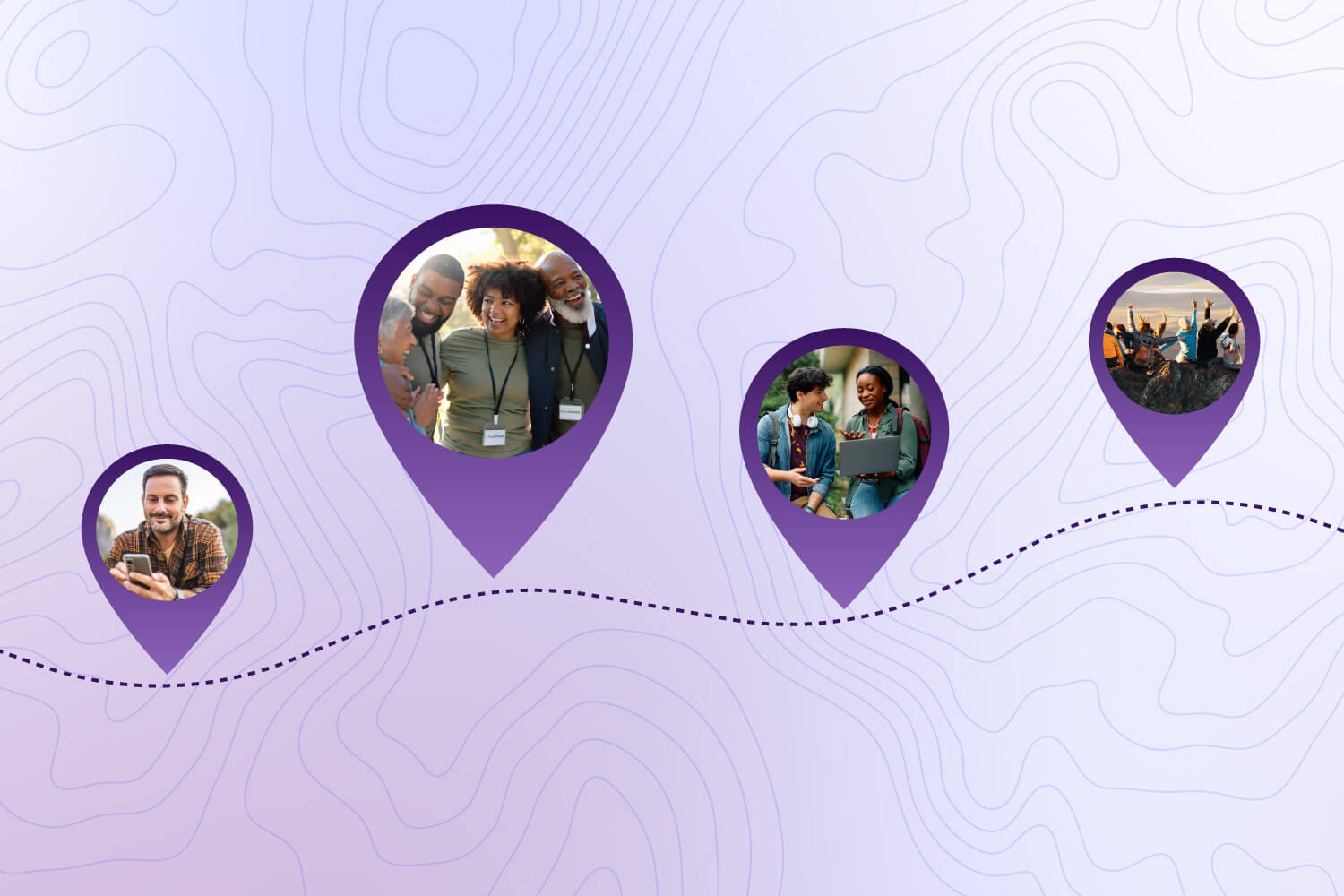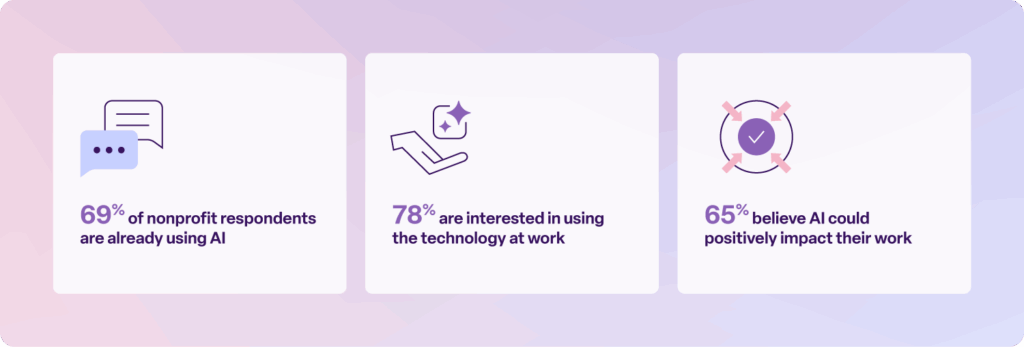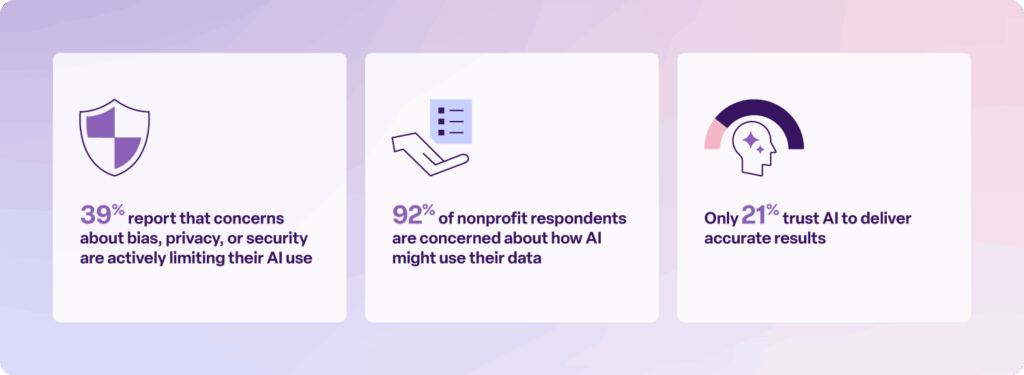Mapping the AI journey: Insights to help nonprofits and funders lead with purpose
How social good leaders are finding their footing in the journey to adopt and apply AI

AI isn’t a far-off peak — it’s the mountain we’re already climbing. Across the social good sector, leaders are learning to navigate new terrain shaped by AI. The promise is clear: Achieve greater impact with fewer resources. But every successful climb begins with preparation, and that’s where readiness matters most.
Bonterra’s new report, “The AI readiness path: Key insights for nonprofits and funders,” charts how organizations are approaching AI adoption, where they’re gaining traction, and what obstacles still stand in their way.
Based on survey responses from 547 nonprofit and 300 funder leaders, the findings reveal a sector that’s curious, cautiously optimistic, and moving with purpose toward ethical innovation.
Let’s dive into five key takeaways:
1. The journey is already underway
Step by step and milestone by milestone, many nonprofits and funders are already embarking on some version of an AI adoption or implementation journey.
Nonprofits

Funders

This steady momentum shows that the question is no longer whether to use AI, but how to use it responsibly and effectively.
From donor segmentation to data visualization to tracking outcomes, the social good sector is beginning to see AI as a collaborator, not a replacement — one that frees up time for deeper human connection and strategic work.
2. Trust and security are the steepest climbs
If the journey to AI adoption is a hike, then trust and security are the hardest parts of the ascent.
The nonprofit vantage point

“Nonprofits handle some of the most personal stories in society, so we set the bar higher than consumer tech. AI should never replace human compassion or decision-making where people’s lives are at stake.” —John Manganaro, Chief Product Officer, Bonterra
These best practices can keep trust at the forefront:
- Embrace human-AI collaboration: AI can draft or analyze, but people must review.
- Use governed tools: Secure, permission-based platforms help protect sensitive data.
- Vet vendors for transparency: Ask where data is stored, how models are trained, and how bias is prevented.
Funders can model this same integrity by publishing clear AI use policies, mandating explainability, and supporting grantees through training and technical assistance.
The funder perspective
Funders also echo many of the concerns expressed by nonprofit respondents — specifically, security and transparency over data usage.

Bonterra’s Responsible AI Commitment rests on three pillars — governance and ethics, privacy and security, and sustainability — ensuring every AI feature supports human judgment and client trust.
“I think the very first safety habit we all must turn on is curiosity. We must ask what is happening, so that we can stay in control of the judgments and decisions we make. We must not offload that part of our work.” — Ben Miller, SVP, Data Science and Analytics, Bonterra
3. Time and cost still slow progress
Even the most passionate missions can lose momentum without time and resources. Over half of nonprofits cite time and staffing as their biggest barriers to adopting AI. Among funders, 40% worry about the high cost of supporting new technology.
Quick wins for efficiency
- Start with what you have: Turn on built-in AI features in your CRM or case management tools.
- Pilot small projects: Four-to-six-week experiments can demonstrate real value quickly.
- Track meaningful metrics: Go beyond time saved — measure how AI improves donor engagement or fundraising results.
Funders are optimistic that once teams clear the early learning curve, AI will help standardize reporting, automate manual processes, and reduce administrative strain — freeing grantees to focus on impact.
4. Clarity builds confidence
Every journey needs basic navigational tools to stay on course. When introducing a technology as transformative as AI, teams need unambiguous policies and direction. Our data suggests, however, that many nonprofits and funders are lacking the desired level of guidance.
Nonprofits

Confidence grows through clarity. Nonprofits can begin by:
- Setting weekly AI use case challenges to practice safely
- Sharing real-world success stories across teams
- Assigning ownership and review for all AI-assisted outputs
Funders

To set an example worth emulating, funders can:
- Host roundtables with vendors or early adopters: Walk through real grantmaking tasks with live examples and allow for Q&A afterward.
- Create a first-use roadmap: Map common processes where AI can assist and where human review is non-negotiable. Pair with simple disclosure language so expectations are clear.
- Share what works: Circulate short highlights from pilots, along with templates and prompt examples, so grantees and peers can borrow proven approaches.
5. People want power-ups, not autopilot
Both nonprofits and funders want AI that empowers humans, not replaces them.
That belief inspired Bonterra Que, the first agentic AI built for the social good sector. Que acts like an embedded teammate within Bonterra’s software — analyzing donor data, drafting emails, and recommending next steps in real time.
“There are enough nonprofits and enough volunteers,” says Chase Russell, SVP of Product Strategy and Marketing, Bonterra. “The challenge is coordination — matching the right donor to the right campaign at the right time. That’s where AI shines.”
For fundraisers like Josh Winfield at Crescent Cove, the results are tangible:
“Bonterra Que absolutely saved me time in helping craft responses or even initial emails to donors. It’s made me a more effective fundraiser.”
Ethical innovation is non-negotiable
Ethical AI isn’t a feature — it’s a foundation. Bonterra ensures that every use of AI is transparent, explainable, and sustainable.
- Client data is never used to train large language models.
- Human oversight is built into every workflow.
- AI systems are deployed on energy-efficient, renewable infrastructure.
AI can be powerful without being opaque — and the most ethical systems invite users to see how results are produced, not just accept them.
The path ahead
Like any mountain worth climbing, AI readiness requires patience and perspective. Early adopters are already seeing results, while cautious users are still mapping their routes.
Whatever the pace, the summit remains the same: greater impact in less time.
Bonterra’s AI tools, like Bonterra Que, serve as a compass for both nonprofits and funders, guiding them from first experiments to long-term transformation.
Continue your climb
Gain deeper data, real-world examples, and practical steps to scale responsibly with AI.
Discover your organization’s AI readiness profile — from Cautious Climber to Impact Innovator — and get personalized next steps.
Work with Bonterra



